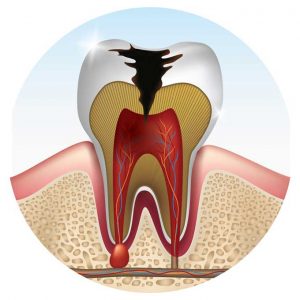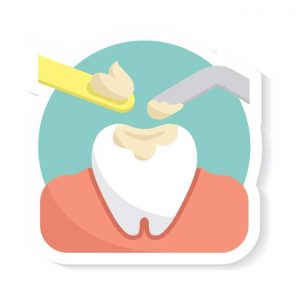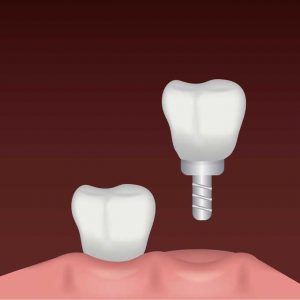Wisdom Tooth Cavity: Symptoms and Treatment Options
Your wisdom teeth, which are located in the very back of each row of teeth, generally begin to emerge sometime during adolescence or early adulthood, or between the ages of 17 to 21 years. You have two sets of wisdom teeth (also called molars) for a total of four teeth. These sets include your upper wisdom teeth and lower wisdom teeth. 
“If you are having pain with a wisdom tooth that you believe is a cavity, it is important to see your dentist. The pain may actually be resulting from other issues with the wisdom tooth that may necessitate it’s removal.”
What is a Cavity?
A cavity is formed when a tooth experiences decay, which can leave a pit in the tooth. This decay happens when your teeth’s protective covering, the enamel, is weakened by the acids and bacteria in the foods you eat. Cavities can be painful, but not always. They are sometimes visible at the surface of the tooth, but other times can be inside the tooth and impossible to see with the naked eye.
You can help prevent cavities by keeping up a regular dental hygiene routine, which typically consists of brushing your teeth twice a day (preferably with toothpaste that includes enamel protection), flossing, and rinsing with mouthwash. Avoiding foods with a high sugar content, sodas, and starchy foods may help you avoid cavities, while some other foods may help fight tooth decay. These healthy foods for your teeth include fruits and vegetables that are high in fiber, some teas, and dairy products and cheeses, which are high in vitamin D and calcium to support bone strength (teeth are bones after all).
Wisdom Tooth Cavity Symptoms
Cavities can sometimes be tricky to diagnose at home, while others may have obvious, visible characteristics. A cavity in your wisdom teeth can be characterized by some or all of the following symptoms:
- Pain or discomfort surrounding your wisdom tooth area, which is in the back of your mouth, at the very rear of each of your gums
- Swelling near the affected area
- Chips, dents, or holes in the surface of the tooth
- Cracked or loose feeling teeth
- Discoloration, usually black spots, on the surface of the tooth
- Sensitivity to certain foods, particularly sweet foods, and sugary drinks
- Bad breath or an unpleasant taste in the mouth
Some other symptoms may be associated with a cavity in your wisdom teeth. The best way to know for sure if you have a cavity in your wisdom teeth is to consult your dentist for an oral exam.
In the event that do find that you have a cavity in your wisdom teeth, your dentist may suggest several options for treatment. Some of these include:
- Dental filling: Cavities can sometimes be filled with a material such as gold, silver, plastic, or porcelain. Filling a cavity can help prevent more acid from reaching the affected area. With proper care, a filling can prevent a cavity from spreading or worsening and decrease pain and discomfort by not allowing food fragments to enter the cavity.
- Dental crowns and caps: Crowns and caps are placed over the teeth to cover and shield surface damage, such as from tooth decay. They help to protect the tooth from further damage by shielding the cavity or affected area from food, drinks, and bacteria. They also help to reshape the tooth and can help strengthen a weak or broken tooth.
- Extraction: In the event that the damaged tooth is beyond repair or is causing you excessive or frequent pain or discomfort, your dentist may suggest that you have it removed. This is a surgical procedure that can often be done with local anesthetics and has a recovery time that can be as little as 24 hours and up to two weeks.
Your dentist may also suggest lifestyle changes that may help prevent future cavities or prevent further damage to existing cavities. These suggestions might include:
- Removing sugary foods from your diet and replacing them with high-fiber vegetables and dairy products.
- Replace sugary drinks and carbonated beverages with fluoride water or a sugar-free alternative.
- Using a fluoride toothpaste. Some types of toothpaste offer extra protection against cavities as well.
- Floss regularly, or after every meal.
- Use a mouth rinse to kill bacteria in hard to reach areas.
- See your oral health care specialist regularly for checkups.
- Change your toothbrush regularly. Some professionals say that you should change to a new toothbrush as often as every three months.
- Take fluoride supplements. Fluoride is important to preventing tooth decay from bacteria.
Not all cavities hurt or cause discomfort, so it is important to be aware of your dental health. Regular dental checkups can help you identify cavities quickly and keep your oral hygiene in check. A cavity in your wisdom teeth, if left untreated, will continue to spread. A small, unnoticeable cavity can easily become a much larger problem that is paired with moderate to severe pain, swelling, discomfort, and sensitivity to certain foods.
When a cavity is caught in the early stages, the tooth can often be saved with a simple dental procedure. A larger or more serious cavity may need to be removed. If you think you have a cavity in your wisdom teeth, schedule a checkup with your dentist for a checkup and to discover your treatment options.
Medically Fact-Checked & Written by Our Dental Editorial Team
You can read more about our editorial guidelines by clicking this link and learn more about the Emergency Dentists USA editorial team here.





